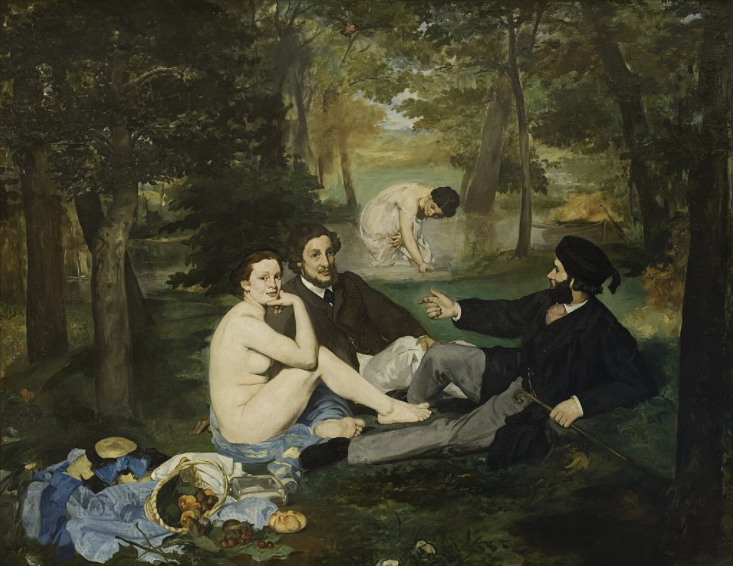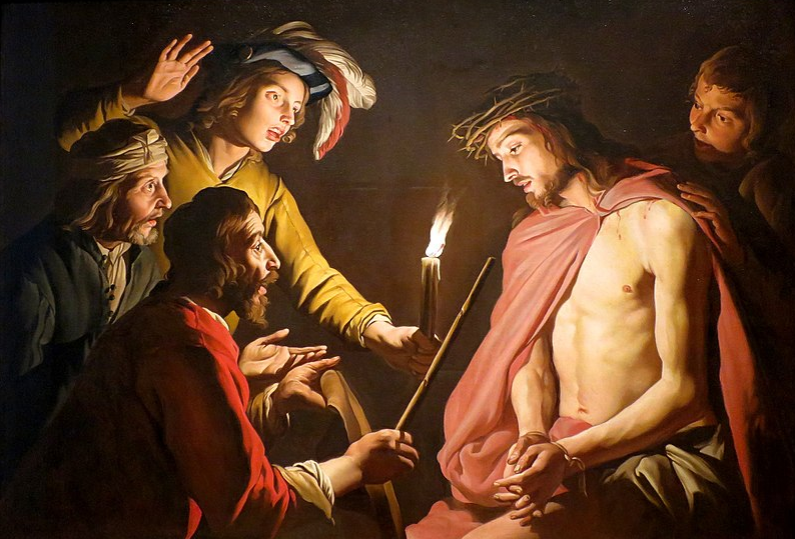Introduction
Artists can use pictorial representations to summarize the themes within a particular historical era, and Matthias Stom and Édouard Manet are no exceptions. Christ Crowned with Thorns is an oil on canvas painting by Storm approximately between 1633 and 1639. It is about 110cm by 161cm and is currently at Norton Simon Museum. The picture sums up the crowning of Christ before his crucifixion on the cross. This form of artwork is an example of Baroque artwork, which can be examined in context, artistic style, and subject matter. The Luncheon on the Grass by Édouard Manet is an enormous oil painting on a canvass, 208 cm by 264 cm. The artwork was drawn between 1862 and 1863. It shows a nude and incompletely nude woman with two well-dressed men in a rural and forest environment. The portrait, previously termed The Birth, is currently found in the Musée d’Orsay Museum in Paris. Although the artists of Christ Crowned with Thorns and The Luncheon on the Grass used the same artistic techniques, like pictorial space, color shading, tone, texture, light, and composition, the two artworks expressed different themes.
Artwork Composition
The Luncheon on the Grass is considered a scandalous piece for the era in which it was written. Already at first glance, it seems that the author’s goal is to shock the viewer, destroying all ideas about contemporary painting. The nude was often found in the works of Manet’s contemporaries, but only gods and other celestials were portrayed this way. Manet makes heroes, not just ordinary people but recognizable contemporaries: Quiz Meuran, a model who often posed for the artist, her brother Gustav and future brother-in-law, Ferdinand Lehnhoff. (Harris and Zucker). Moreover, the primary purpose that Manet created the artwork was to bridge the gap between realism and perfectionism, as he chose to show his rejection of the traditional tastes of art (Evans 249). These three individuals appear to be sitting on the grass, with the nude woman’s clothes on one grass surface. An individual needs to think during historial art analysis to create the best interpretation critically (Glass). Historical portraits preserve the culture of the people who lived in the painting’s period.
In Christ Crowned with Thorns art, the artists carefully chose figures within the drawing to create symbolism and show thematic concerns within the particular historical period. Matthias decided to use a single candle in the center of the picture to illuminate the subjects in an environment that presents darkness. In the painting by Stom Christ Crowned with Thorns, Jesus, surrounded by four tormentors, appears before the viewer with an air of solemn humility. The picture’s plot is one of the episodes of the Passion, the Way of the Cross of Christ. The prayer-philosophical nature of the interpretation of the canonical, typical plot allows us to create a visual paraphrase of the theme of imitations of Christ. The way the artist painted the image makes an observer fall into an empathic mood, as Christ looks at the candle with a sense of hopelessness (Hodne 247). The propelling aim that drove the painter was the theme of Christianity. He wanted to illustrate the suffering that Christ underwent through art.
Artwork Lines
Both artworks have used different form lines to depict various form lines to show different distances from the foreground. In The Luncheon on the Grass, various diagonal lines can be observed in the picture (Harris and Zucker). A horizontal line separates the river that the lady is standing in from the background. A similar line also exists, separating the far background from the white sky. In Matthias Stom’s artwork, diagonal lines show an angle through which the people in the foreground are slanting. The three individuals on the left appear to be leaning at the same angle toward the candle. In Christ Crowned with Thorns, the color shading in the image can help an observer identify the people in the background. The foreground individuals shine because of the illumination of the light, while the background person receives less illumination from the candle.
Artwork Lighting
In Christ Crowned with Thorns, lighting is used to illuminate the individuals in the painting. The environment is dark, and Christ, in the foreground, appears more illuminated by the light than the person immediately behind him (Harris and Zucker). The candlelight has revealed the shining light of the individuals in the foreground. Based on The Luncheon on the Grass, the trees appear to be blocking the rays of the sun (Richman-Abdou). There appear scattered bright lighting within trees in the forest, showing the brilliant sunlight. The distant end with lesser trees appears brighter, perhaps due to the sunshine.
In The Luncheon on the Grass, the painter has performed excellent picture shading to reveal the chemise-wearing woman bathing in a river. The color group has been well selected as the colors fade to the background, making the viewer estimate the objects far (Harris and Zucker). It is observed that the trees closer to the foreground have been shed with a darker color. The color painting fades as an observer views the distantly placed trees in the background. The picture’s composition shows how Manet matched the natural ecosystem through different shading intensities of the natural objects presented in the drawing.
Both artists used lighting to create shadows on their artworks, as shown by the reflections. According to The Luncheon on the Grass artwork, the man lying on the grass produced a shadow. A careful observation of the picture can also reveal different shadow intensities within the forest (Harris and Zucker). It may be because of the reflection created by the sunlight trying to penetrate through the closely packed trees. In Christ Crowned with Thorns painting, the artist has effectively used lighting to illustrate shadows (Norton Simon Museum). Shadows are detailed on Christ’s red robe. A shadow of Christ’s hands can also be observed on his knees, emphasizing the painter’s aim to use lighting in his work.
The two forms of art have entailed pictorial space to show that both scenes are in a three-dimensional state. In The Luncheon on the Grass, the artist uses linear perspective to add more sweetness to his art (Harris and Zucker). In reality, the size of the boat should be larger than the size of an individual. However, one man lying on the grass appears to be bigger than the boat in the river. This size variation develops an impression of space within an individual’s mind. In Christ Crowned with Thorns drawing,
Conclusion
space is compressed within the scene by fitting the characters near each other. A close observation of the characters reveals a three-dimensional event within the picture close together.
In conclusion, Christ Crowned with Thorns was motivated by the spreading of Christianity in the Roman Catholic church. Creating his painting The Luncheon on the Grass, Edouard Manet was driven by the rejection of the traditional art form, so he began to try new techniques in painting. Both artists used different methods in composition, space, and color to create lifelike pieces. Nevertheless, the two pictures have different themes.
Works Cited
Evans, Laura. “Famous Works of Art—and How They Got That Way.” Studies in Art Education, vol. 58, no. 3, 3 July 2017, pp. 246–248, Web.
Glass, Dr. Robert. “Introduction to Art Historical Analysis – Smarthistory.” Smarthistory.org, Web.
Harris, Dr. Beth, and Dr. Steven Zucker. “How to Do Visual (Formal) Analysis – Smarthistory.” Smarthistory.org, 2021. Web.
Hodne, Lasse. “Memling’s portraits of Christ. A cognitive approach.” Acta Ad Archaeologiam et Artium Historiam Pertinentia, vol. 31, no. 17 N.S., 31 Dec. 2019, pp. 245–258, Web.
Norton Simon Museum. “Christ Crowned with Thorns» Norton Simon Museum.” Www.nortonsimon.org, Web.
Richman-Abdou, Kelly. “The Significance of Manet’s Large-Scale Masterpiece ‘the Luncheon on the Grass.’” My Modern Met, 2018, Web.
Appendix

